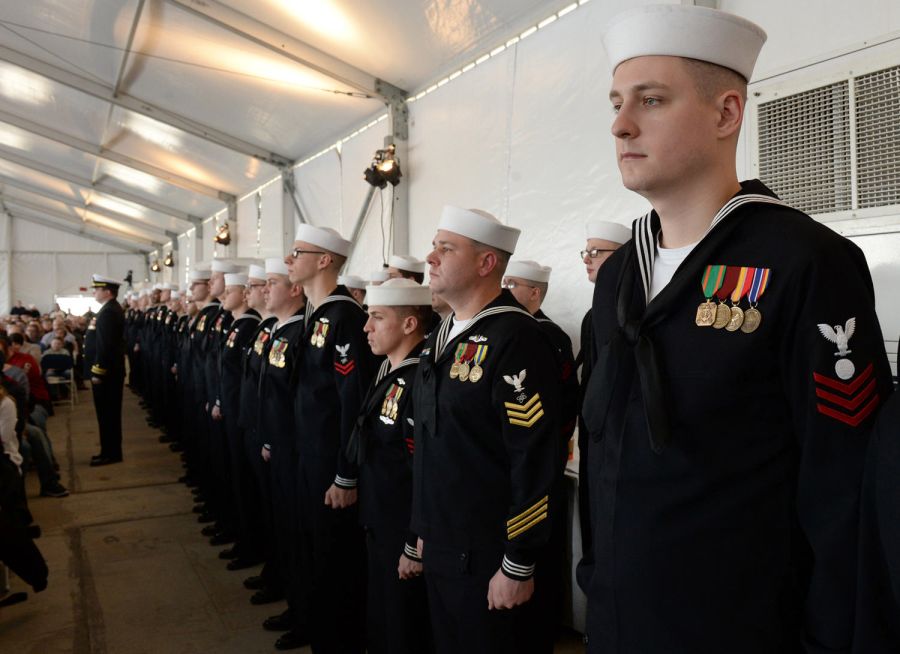Navy Ending Red ‘Misconduct’ Stripes
Military culture is a strange beast.

Stars and Stripes (“Gold for all: Navy ending use of red ‘misconduct’ uniform stripes“):
The Navy is doing away with “misconduct” red stripes for senior sailors, among other changes outlined in a new uniform policy released Monday.
The 13 changes are a result of feedback received from the fleet, according to the message signed by Chief of Naval Personnel Vice Adm. Robert Burke.
Starting June 1, all sailors over the 12-year service mark will be authorized to wear gold chevrons on their dress and service uniforms, a stark contrast to the red stripe worn by some senior enlisted sailors as a visible sign of misconduct from some point in their careers.
The current policy mandates that sailors who have received nonjudicial punishment or court-martials within the past 12 years wear red stripes. Sailors who already have reached the milestone had to restart the 12-year clock if they had further infractions. Each stripe represents four years of service, with the gold previously indicating good conduct.
While multiple enlisted sailors welcomed removal of the stigma associated with red stripes, others online cried foul on the CNP Facebook page, viewing their gold stripes as a badge of honor.
“Gold stripes mean something,” one user commented. “Some traditions are worth keeping, this was one of them,” another said.
“It says you did the right things for over a decade and it was reflected on your uniform,” Chief Petty Officer Steve Owsley, who has gold stripes and has been in the Navy just shy of 20 years, told Stars and Stripes. “Many times, when servicemembers make a mistake in the Navy, the most important part is to own that mistake and accept responsibility for it.”
Military.com (“Sailors Will No Longer Need 12 Years of Good Conduct to Sport Gold Stripes“):
The Navy is rescinding its long-standing tradition requiring sailors to have 12 years of blemish-free conduct to rate gold stripes, officials announced Monday.
Soon, it won’t be so easy to spot enlisted sailors who’ve gotten into some trouble in the past. Starting June 1, sailors with less-than-perfect records will no longer be required to wear red service stripes and rating badges on their uniforms in place of gold.
“All enlisted Sailors with 12 cumulative years of naval active or active reserve service are authorized to wear gold rating badges, and gold service stripes in lieu of red rating badges and stripes,” Navy-wide administrative 075/19 states.
The message was signed by Chief of Naval Personnel Vice Adm. Robert Burke. Lt. j.g. Stuart Phillips, a spokesman for Burke’s office, said senior-enlisted feedback from the fleet prompted the Uniform Matters Office to look at revising the rules for gold rating badges and service stripes.
“The feedback received stated the desire in the fleet is for there to be a single criteria that encompasses the achieved milestone of all enlisted sailors with 12 years of service,” Phillips said.
Under the current regulation, only those who meet the minimum requirements for the Good Conduct Award can wear gold rating badges and service stripes, each of which marks four years of service. If a sailor hits the 12-year mark before meeting those requirements, they wear red stripes.
Sailors who have qualified for the gold stripes but are later convicted by court-martial or nonjudicial punishment (NJP) must also switch to red. At that point, the 12-year clock to earn the gold stripes back starts over again. That means most end their careers before requalifying.
The policy change was apparently spurred by a plea from Chief Musician Jessica Privler in the June 2017 issue of Proceedings titled “From the Deckplates—Base Gold Stripes on Service, Not Conduct.”
Navy traditions inspire pride in our identity and link us to our past. But time alone does not make traditions worthy. With that in mind, it is time for the Navy to dispense with its use of the red service stripes and rank as a way to visibly identify its enlisted Sailors without 12 years of good conduct in the Navy.
When a Sailor’s misconduct leads to a disciplinary action, it often results in a captain’s mast and a nonjudicial punishment (NJP). An NJP is a non-criminal conviction; punishment can include reprimand, restriction, correctional custody, loss of pay, or reduction of rank. But are these not adequate sentences? Must one also atone for wrongdoing by being marked with differentiating uniform components?
In some cases, it is a new Sailor who receives an NJP in his or her first enlistment. That Sailor may go on to have a successful and productive career, only to be reminded of the early transgression when, upon reaching the 12-year mark, he or she is unable to wear gold rank and service stripes. Sometimes the disciplinary action comes late enough in a Sailor’s career that he or she is never able to wear gold.
Leaders must make the distinction between those whose infractions can be only punishable by separation from the Navy and those for whom rehabilitation is the answer. If we choose the latter, it must mean that we see potential in those Sailors, and that with a second chance, and with good leadership and mentoring, they can thrive and be successful in the Navy. If the Sailor remains in the Navy, then his or her service should be valued as much as the service of his or her peers, and all their uniforms should reflect that. We cannot be a Navy with one uniform for the virtuous and one for the “not quite good enough.”
The dysfunction of the red versus gold rank and service stripes extends beyond the punitive to the perplexing, as those with prior military service are similarly affected. Service stripes reflect all military time served, but the transfer to gold rank and stripes reflects only naval service. Therefore, anyone who served in another branch of the military before enlisting in the Navy, regardless of conduct, will reach 12 years of service prior to being authorized to wear gold.
Sailors wearing three or more red service stripes are likely to face judgment—even if subconscious—by peers, subordinates, and leaders. Red service stripes can humiliate the wearer and invite gossip, speculation, or conjecture. They can lead to incorrect assumptions and further prejudices against those Sailors, causing others to mistrust their work or devalue their potential.
Ultimately, we must ask ourselves what the goal of this regulation is and what it achieves. If the answer is public shaming, then the Navy is successful. But when is such a practice ever the goal in discipline? We have heard the saying, “praise in public; admonish in private.” There is no privacy in three or more red service stripes on a uniform advertising, perhaps, one moment of poor judgment. Furthermore, there is no way to differentiate between a conduct incident and prior service. Standardizing the color of rank and service stripes and basing the color on time in service only would eliminate confusion and bring continuity to the uniform. And by leaving this tradition behind, we would allow Sailors to move on from their past mistakes.
From a soldier’s perspective, the old policy is simply bizarre and it’s shocking that it persisted this long.
As Privler notes, a leader with the red stripes would surely be seen as less worthy than the one with gold stripes. That hinders their ability to do their job, which hurts the unit as a whole. It simply makes no sense to me to declare someone worthy of more responsibility by promoting them to a higher rank while simultaneously marking them with a literal scarlet letter.
Additionally, Privler is right to note the strangeness of those, like herself, who transferred from another service to be branded as misfits. While some will ask, most will simply assume that they have one or more instances of misconduct on their record.
Indeed, I’d argue that the policy change simply doesn’t go far enough. Why not simply make all the insignia the same color—whether gold for all ranks or red for junior petty officers (PO3, PO2, PO1) and gold for senior petty officers (Chief Petty Officer and above)? Otherwise, we have the perverse effect of calling negative attention to fast-risers who have earned a promotion but not yet achieved twelve years of service. Conversely, we also highlight slow-risers by turning their stripes gold when they’ve been in long enough to be at a much higher rank.
Of course, the Navy isn’t the Army and the policy change is judged against the existing tradition, not logic.
So, naturally, the reaction against Privler’s suggestion was pretty harsh. Most obviously, because she’s a “mere” musician rather than a “real sailor,” people question why she even gets to have an opinion about such things. The fact that she transferred over from the Army band merely reinforces that “argument.”
More importantly, the gold stripes are seen as a badge of honor. Giving them to those with misconduct in their records is viewed by many as diminishing that honor and amounting to a “participation trophy.” That it would no longer be an honor one way or the other—just a rank insignia—and that we already recognize a clean record with the Good Conduct Medal are beside the point. (The Army, incidentally, went through similar gnashing of teeth when it made black berets, previously the marker for the elite Ranger Regiment, the standard-issue headgear. People were still bitching about that for a decade after the change.)
Further, a couple of commenters make the good point that seeing senior leaders with “misconduct” stripes can actually be a good thing. It signals to young sailors who have made a mistake that there’s still hope for a bright future career in the Navy if they get their act together.
That said, I think the benefits of the change outweigh the harm.






There’s three ways to do anything:
1. The right way
2. The wrong way
3. The Navy way
I never thought I would see the day when my old career (“Army Band”) would appear in the writings of Mr. James Joyner. Yes indeedy, military band members are teased mercilessly at all times and in all places. Because we play in the public eye, we are often tossed up as wasteful spending. Never mind that the entire budget of military music is burned off in aviation jet fuel every hour, 24/7/365.
SFC, US Army, Retired
@John Peabody:..military band members are teased mercilessly at all times and in all places…we are often tossed up as wasteful spending.
A fellow I met several years after the Vietnam War ended told me about when he was 19 or 20 in the late 60’s he was before a judge who gave him the option of jail time or join the military. He enlisted in the Army.
Somehow he was stationed in South Korea and never went to the jungle. He ended up joining some sort of military choir and spent his hitch touring the peninsula entertaining audiences.
Don’t recall him mentioning any taunting.
Not a bad sentence. I suspect that jail time in the states would not have been as harmonious.
Holy scarlet letters. Next we’ll learn that the navy is doing away with keel-hauling!
The red stripes are also so much less visible. I didn’t even see the front sailors stripes at first. If the stripes mean anything important, then they have to at least be visible.
It didn’t use to be that way. Back when I joined the Navy the crusty red-stripers were respected and it was an example that a person could screw up and still be a leader. A far cry from today’s zero-tolerance military where one bad PT score can end your career.
Yes red stripes were weird, but except in formal occasions the red/gold stripes aren’t worn by folks on sea commands, only on formal uniforms (think suits – so worn by Sailors on shore duty). But the bigger change (or opportunity) is this open letter (the word “mess” means the group of E-7 and above at a particular command, refers back to the old days of sailing ships and eating together)
https://blog.usni.org/posts/2019/03/22/message-to-the-mess-earn-back-the-sailors-trust